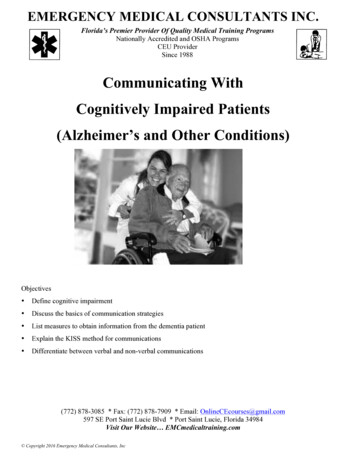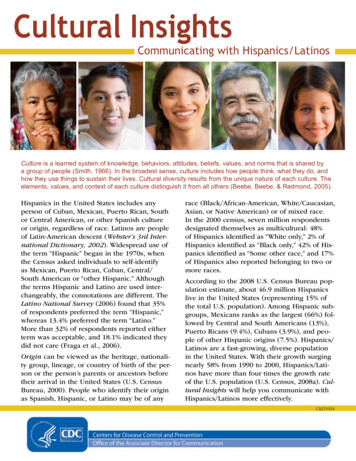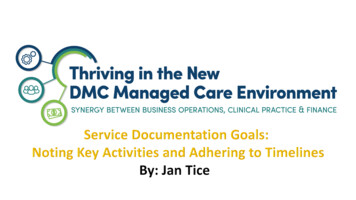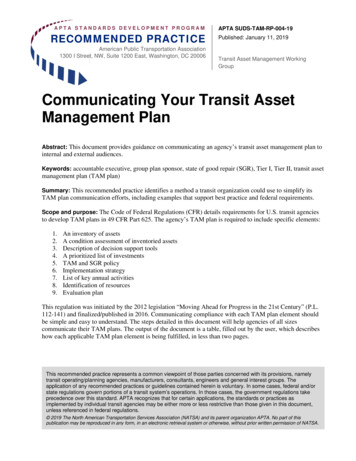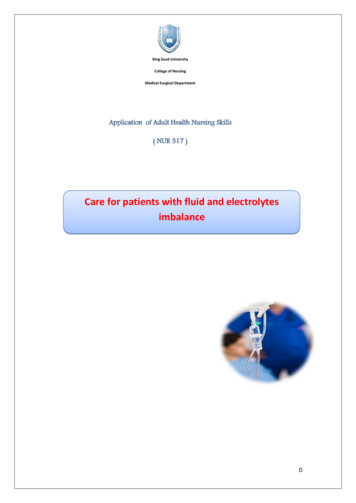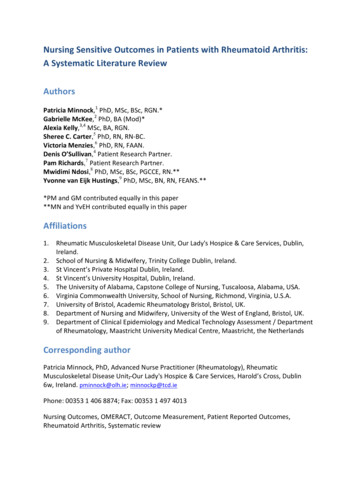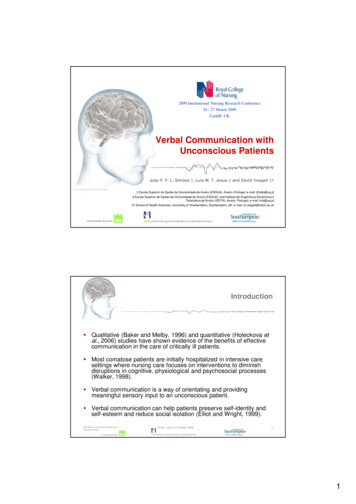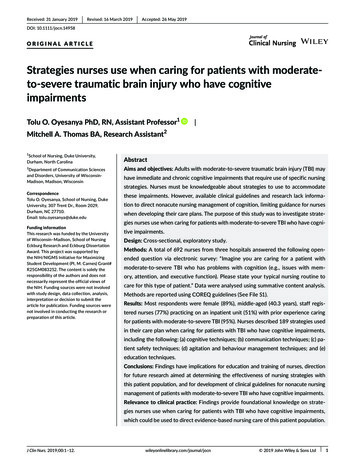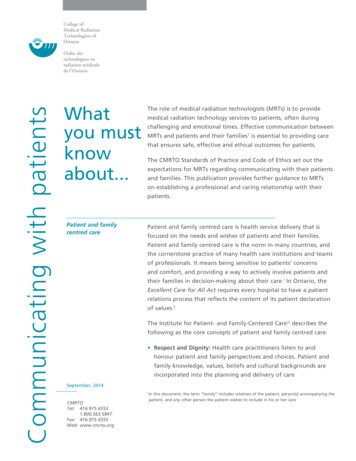
Transcription
Communicating with patientsWhatyou mustknowabout.The role of medical radiation technologists (MRTs) is to providemedical radiation technology services to patients, often duringchallenging and emotional times. Effective communication betweenMRTs and patients and their families1 is essential to providing carethat ensures safe, effective and ethical outcomes for patients.The CMRTO Standards of Practice and Code of Ethics set out theexpectations for MRTs regarding communicating with their patientsand families. This publication provides further guidance to MRTson establishing a professional and caring relationship with theirpatients.Patient and familycentred carePatient and family centred care is health service delivery that isfocused on the needs and wishes of patients and their families.Patient and family centred care is the norm in many countries, andthe cornerstone practice of many health care institutions and teamsof professionals. It means being sensitive to patients’ concernsand comfort, and providing a way to actively involve patients andtheir families in decision-making about their care.i In Ontario, theExcellent Care for All Act requires every hospital to have a patientrelations process that reflects the content of its patient declarationof values.iiThe Institute for Patient- and Family-Centered Careiii describes thefollowing as the core concepts of patient and family centred care: R espect and Dignity: Health care practitioners listen to andhonour patient and family perspectives and choices. Patient andfamily knowledge, values, beliefs and cultural backgrounds areincorporated into the planning and delivery of careSeptember, 2014In this document, the term “family” includes relatives of the patient, person(s) accompanying thepatient, and any other person the patient wishes to include in his or her care1 CMRTOTel: 416.975.43531.800.563.5847Fax: 416.975.4355Web: www.cmrto.org
I nformation Sharing: Health care practitioners communicateand share complete and unbiased information with patientsand families in ways that are affirming and useful. Patients andfamilies receive timely, complete, and accurate information inorder to effectively participate in care and decision-making2 Participation: Patients and families are encouraged and supportedin participating in care and decision-making at the level theychoose3 C ollaboration: Health care leaders collaborate with patients andfamilies in policy and program development, implementationand evaluation; in health care facility design; and in professionaleducation, as well as in the delivery of carePatient and familycentred care in medicalradiation technologyIt is sometimes challenging for MRTs to incorporate the coreconcepts of patient and family centred care when they providemedical radiation technology services to patients. The time requiredfor diagnostic and therapeutic procedures is relatively short, whichmakes excellent communication skills essential. Radiation therapistsmay see their patients for a short time each day over an extendedperiod, while treatment is administered. MRTs practising indiagnostic imaging often never see their patients again and it maytake only 5 or 10 minutes to complete the examination.MRTs routinely work with patients who are vulnerable and in needof extra care. Whether they are young or elderly, or have specialneeds, or are in pain, or have cancer or multiple injuries, patientsand their families are often interacting with MRTs at a time whenthey are stressed and anxious. In busy imaging and radiationtherapy departments it is easy for MRTs to focus on the complexequipment and patient throughput times, but this can mean thatthe patient and his or her family may perceive their care as lessthan optimal. In order to be perceived as providing quality care toany group of patients, MRTs should not focus solely on the task ofperforming the procedure or treatment, but place the individualpatient at the centre of the process by caring for their emotionalneeds as well as providing physical care.iv2 MRTs are reminded that information sharing with patients and families must be done inaccordance with the CMRTO Standards of Practice and Code of Ethics and applicable legislationsuch as the Personal Health Information Protection Act and the Health Care Consent Act3 MRTs are reminded that with respect to participation in a patient’s care by family members, it isthe patient or his or her substitute decision-maker that provides informed consent regarding hisor her care, in accordance with the Health Care Consent Act2
It is essential that MRTs treat all patients and their families withrespect and dignity, provide information about the procedure ortreatment that is useful to the patient and encourage the patientand/or family member to participate in the procedure or treatmentas appropriate. It is often the small and simple collaborations thathave the greatest positive impact for the patient: for example, askthe patient to explain the best method to transfer him or her to thetable, or listen to the family member or person accompanying thepatient when they explain the best method to help calm the patientfor the diagnostic or therapeutic procedure and act on their advice.Encouraging patients and their families to collaborate andparticipate in the diagnostic or therapeutic procedure, asappropriate, helps them retain autonomy and control, and improvesco-operation for improved patient outcomes.Remember, MRTs are experts in providing medical radiationtechnology services to patients, but the patient and his or her familyare expert in the patient’s needs.vCommunicatingwith patientsEffective communication between health professionals and patientsis vital. Considerable responsibility is placed on health professionalsto communicate effectively by paying attention to the ways in whichinformation is conveyed and words are selected when speaking topatients. MRTs must also be active and compassionate listeners andshow sensitivity to their patients’ concerns and needs. Awarenessof cultural and physical barriers that may interfere with clearcommunication – and respect for these differences – help MRTspractise the profession in a responsive and responsible manner.MRTs need to consider communication as an essential part of theassessment of a patient before, during and after a diagnostic ortherapeutic procedure.4 Patient assessment starts with the initialcontact with the patient when the MRT assesses items such as clinicalinformation, signs and symptoms, and the ability of the patientto cooperate, understand and consent to the procedure. It is thisassessment stage that reinforces the need for the MRT to haveexcellent communication skills.vi For example, MRTs ask43 he scope of practice statement for medical radiation technology is set out in the MedicalTRadiation Technology Act, as follows:“The practice of medical radiation technology is the use of ionizing radiation, electromagnetismand other prescribed forms of energy for the purposes of diagnostic and therapeutic procedures,the evaluation of images and data relating to the procedures and the assessment of anindividual before, during and after the procedures.”
patients to confirm their personal information prior to commencingthe procedure, MRTs inform patients of what to expect duringthe procedure, provide instructions on position and breathingrequirements and, at the end of the procedure, inform them of thenext steps and the expected time of the results or findings.It is a necessary part of MRTs’ practice to touch their patients toensure that the patient is in the correct position for the diagnosticor therapeutic procedure. It is essential that MRTs explain topatients, before they touch them, when and where the MRT willtouch them and why and ensure they have the patient’s consentto proceed.5 Patients expect practitioners to provide them withinformation about what is about to happen. This makes patientsfeel more in control and supports their autonomy in an otherwisedifficult and potentially frightening experience.viiThe patient’sperspectiveMRTs always need to be aware of patient vulnerability and anxiety.For diagnostic and therapeutic procedures, patients are oftenrequired to remove their clothing, enter dimly lit and noisy roomsthat contain large and complex equipment, receive injections orundergo uncomfortable or embarrassing procedures, and may berequired to hold still in painful or awkward positions for lengthyperiods of time. While MRTs accept that technology is at the centreof their practice, for patients the environment and the experiencecan be very depersonalizing.viiiPatients are also concerned about the outcome of the procedure– will this procedure show my cancer has returned? How severeis my child’s head injury? Will this treatment cure my cancer? Hasmy grandmother fractured her hip? Do I need to have open-heartsurgery?Patients attribute the perception of ‘quality’ to examinations wherethey perceive the practitioner as interested in them and whenthe practitioner projects a warm and caring demeanor.ix MRTs areuniquely able to make the procedure as comfortable as possible fortheir patients and help alleviate their anxiety.54See the CMRTO Standards of Practice
Elements of effectivecommunicationThere are three aspects to communication: sender, messageand receiver. MRTs are in the role of sender when they informpatients about the procedure and what they are going to do. Theinformation that MRTs share with patients is the message, andthe patient is the receiver. But when MRTs check with the patientto confirm the patient understands the procedure, or the patientconsents to the procedure, MRTs are in the role of receiver. Effectivecommunication involves a sharing of information with each personmoving between the role of sender and receiver.Non-verbal communication is also very important. MRTs need tobe aware that there are many ways of sharing – more than justthe verbal transmission of what you want to say. Many factorscontribute to the patient’s ability to receive and understand whatwe are saying, including body language, tone of voice, pace ofspeech, use of gestures and other non-verbal behaviour. Patientsoften listen more to ‘how something is said’ rather than ‘what issaid’. Patients may pick-up on a negative tone of voice and sufferanxiety or misapprehension. When interacting with patients, MRTsneed to use eye contact appropriately, exhibit a caring attitude anduse body language that communicates openness. They need to keepin mind that effective communication includes not only the messagedelivered but also the way in which that message is received andunderstood.There is often an assumption that, during a procedure or treatment,the MRT and the patient interacted with a full understandingof each other.x However, this is not always the case. Faultycommunication is a common reason for safety errors. The CMRTOreceives more complaints about communication issues than abouttechnical issues.xi For these reasons, the CMRTO has developed theCommunication Guidelines set out in this publication to assist MRTsin communicating with their patients.Expectations forProfessional Practice CMRTO Standards ofPracticeThe CMRTO Standards of Practice have been developed by theCMRTO to describe the expectations for professional practiceof MRTs. The Standards of Practice describe what each MRTis accountable and responsible for in practice, and reflect theknowledge, skills and judgement that MRTs need in order toperform the services and procedures that fall within the scopeof practice of the profession. Every diagnostic and therapeuticprocedure performed by an MRT involves a patient.5
The CMRTO Standards of Practice includes Practice Standard 5 Relationship with Patients, which states that MRTs have patient careas their main concern. The Practice Standard sets out the followingexpectations for MRTs:M RTs must maintain clear and professional boundariesin relationships with patients and treat all patients withdignity and respect. MRTs must have the knowledge, skillsand judgement to avoid placing patients at unnecessaryrisk of harm, pain or distress. MRTs must be able to provideappropriate responses to patient inquiries about proceduresand related issues, and accept the patient’s autonomy andthe right of the patient or the patient’s substitute decisionmaker to consent to or refuse service. MRTs must understandhow and act to protect the confidentiality of all professionallyacquired information about patients and the privacy ofpatients with respect to that information, while facilitating theeffective delivery of health care.Under the CMRTO Standards of Practice, MRTs are expected to becompetent, accountable and collaborative.The summary chart at the end of this publication lists the practiceindicators relating to communicating with patients from the CMRTOStandards of Practice.Expectations forResponsible Conduct CMRTO Code of EthicsThe CMRTO Code of Ethics is a set of principles that delineatesresponsible conduct and the ethical and moral behaviour of MRTs. Ithas as its foremost goal the welfare and protection of patients andthe public.The Code of Ethics is intended to help MRTs choose the right,fair, good and just action. Each MRT is personally responsible forbehaving according to the ethical principles set down in the Code.The Code of Ethics is to be used in conjunction with the CMRTOStandards of Practice. Together, these documents provide a modelfor ensuring safe, effective and ethical professional performance toensure safe, effective and ethical outcomes for patients.Ethical Principle 2 relates to MRTs’ responsibility to patients andsets out how MRTs act in the best interests of their patients. Thesummary chart at the end of this publication lists the ethical6
indicators from the Code of Ethics related to expectations for MRTsto act in the best interests of their patients.CommunicationGuidelinesThese guidelines are designed to assist MRTs in applying the CMRTOStandards of Practice and Code of Ethics and to provide additionalguidance to MRTs regarding communicating with patients andtheir families.6 Following the guidelines below will help MRTsachieve safe, effective and ethical outcomes for patients whenthey communicate with patients and their families and when theyperform diagnostic and therapeutic procedures.1. Greet your patient and their family or accompanying person in awelcoming manner and with eye contact and a positive attitude.2. Introduce yourself to your patient, tell them your profession andwhat procedure you are going to do. Introduce anyone else whomay be present for the procedure and explain his or her role. Askyour patient whether they object to any non-essential personbeing present.3. Ask your patient how they wish to be addressed (Mr. Smith,Robert or Bob). If in doubt, use the patient’s formal name. Don’tuse colloquial expressions such as ‘dear’ or ‘sweetie’.4. Clarify the role of any family member or accompanying personpresent (substitute decision maker? interpreter? personalsupport?). Wherever possible, ask your patient first if they wouldlike the person to be involved and support the person in assistingyour patient as appropriate to the situation.5. Encourage your patient and any family member or accompanyingperson to participate in the procedure, where appropriate (e.g.helping to change, transferring to the table, providing support).6. Show a respectful and caring attitude towards your patient bylistening to and respecting his or her perspectives and choices.7. Be aware of your own body language, tone of voice andnon-verbal behaviour to ensure effective communication.It should be noted that these guidelines are not themselves standards of practice. The CMRTOStandards of Practice prevail over these guidelines. However, the guidelines may still be used bythe CMRTO to assist in determining whether appropriate standards of practice and professionalconduct have been maintained by an MRT in a particular case. These guidelines supersede andreplace the CMRTO’s “Communication and Touching Principles” published in “What you mustknow about .sexual abuse”, updated October 20056 7
8. M aintain a professional and friendly relationship with yourpatient and his or her family. Don’t be overfamiliar, dismissive orcondescending.9. S peak directly to your patient, using eye contact and being atthe same physical level, if possible. Remember, patients whoare non-responsive or who appear not to be aware of theirsurroundings can often still hear.10. Provide your patient with timely, complete and accurateinformation about the procedure, such as what to expect andhow long you expect the procedure to take. Use language andterminology that your patient can understand. Check to makesure that your patient understands.11. Respond professionally and respectfully to any questions orconcerns your patient may have.12. Actively listen to your patient in order to be aware of his or herconcerns and anxieties, and respond appropriately throughoutthe procedure. Observe your patient for changes in facialexpressions and body language. Check to make sure that yourpatient is still comfortable and whether your patient has anyquestions. Remember, not all patients verbalize their concernswhen they are anxious or upset.13. Reserve judgement, and never make assumptions.14. Maintain your patient’s dignity and keep your patient ascomfortable as possible throughout the procedure.15. If possible, give your patient positive directions (e.g. “keep stillplease” rather than “don’t move”). Provide positive feedbackand encouragement throughout the procedure.16. Support your patient’s autonomy by respecting his or herdecision to change his or her mind, pause or terminate theprocedure at any time.17. At the end of the procedure, thank your patient, confirm thenext steps, and ask if there is anything else you can do.8
Barriers to effectivecommunicationThere are a number of factors that create difficulties when MRTscommunicate with patients. These include:MRTs’ attitudes: N egative stereotyping of patients and a lack of understanding oftheir unique needs or situation, or the nature of any disability M aking assumptions about or judging people, their family or theirabilities B eing under pressure and in a hurry to explain, not taking time tolisten to or fully communicate with their patients F ocusing on the procedure or the equipment rather than thepatient H aving an overfamiliar or condescending attitude to patients T aking personal or professional offence to comments or questionsraised by the patient or their family or accompanying personOrganizational factors: L ack of knowledge, or availability of resources to assistcommunication, such as interpreters and written information R igid appointment times F ocus on throughput rather than patient care L ack of communication among the members of the health careteam U navailable or confusing policiesEnvironmental factors: N oise from the equipment in imaging and radiation therapydepartments making it difficult to hear L ack of private space for discussions with patients M RTs standing behind screens at a distance from the patient thatcan affect their ability to hear L ow levels of lighting in imaging and radiation therapy roomsmaking it difficult to see people’s faces, facial expressions and lips9
W earing face masks during some procedures can make it difficultto see people’s faces, facial expressions and lipsxiiConsidering all these factors it is not surprising that MRTs mayrecall occasions when they could have been more effective in theircommunication with patients and their families. Communicationis a complex and dynamic process. Given all the unique situations,range of patients and their needs, and complexity of imaging andradiation therapy departments, it is not surprising if sometimescommunication attempts fall short of their goals. However, in lightof a responsibility to provide patient and family-centred care, it isa continual and on-going process for MRTs to develop and improvetheir communication with patients.MRTs contribute toquality patient carethrough respectful,caring and effectivecommunicationThe CMRTO Standards of Practice, Code of Ethics andCommunication Guidelines provide an effective framework forMRTs to provide respectful, caring and effective communicationwith patients and their families. MRTs must perform theirduties responsibly and in a manner that reflects the profession’scommitment to respect the personal dignity of every individualwho entrusts himself or herself to the care of MRTs.AcknowledgementsThe College of Medical Radiation Technologists of Ontario wouldlike to thank all contributors for their input into the creation ofthese guidelines and publication. This includes the professional andpublic members of the CMRTO Council and the medical radiationtechnologists who participated in a focus group on communicatingwith patients in August 2014. In addition, a special thank you toAndrea and AJ Fordham, whose experiences and suggestions wereinvaluable in identifying the need for, and the development of,these guidelines.10
7e. p roviding individualized, comprehensive andsafe treatment during examinations or therapysessions, taking into account the patient’sparticular physical and emotional needs, valuesand cultural background; andd. t reating all patients equitably, regardless of race,ancestry, place of origin, colour, ethnic origin,citizenship, creed, sex, sexual orientation, genderidentity, gender expression, age, marital status,family status, disability or type of illness;74. C larify the role of any family member oraccompanying person present (substitute decisionmaker? interpreter? personal support?). Whereverpossible, ask your patient first if they would likethe person to be involved and support themin assisting your patient as appropriate to thesituation.3. A sk your patient how they wish to be addressed(Mr. Smith, Robert or Bob). If in doubt, use thepatient’s formal name. Don’t use colloquialexpressions such as ‘dear’ or ‘sweetie’.2.Introduce yourself to your patient, tell them yourprofession and what procedure you are going todo. Introduce anyone else who may be present forthe procedure and explain his or her role. Ask yourpatient whether they object to any non-essentialperson being present.1. G reet your patient and their family oraccompanying person in a welcoming mannerand with eye contact and a positive attitude.11 In September 2014, CMRTO updated section 2d of the Code of Ethics to be consistent with changes in the Ontario Human Rights Code by adding “gender identity” and “gender expression”, and by removing“same sex partnership status”5e. c arry out diagnostic or therapeutic proceduresonly with the informed consent of the patientor the patient’s substitute decision maker3h. ensure that patient consent has been obtained5d. r efer questions of the patient or patient’ssubstitute decision maker that are outside thescope of MRT responsibility to an appropriatehealth professional for answers5c. p rovide the patient or patient’s substitutedecision maker with answers to his or herquestions within the scope of MRT responsibility5b. g ive the patient or patient’s substitute decisionmaker an opportunity to ask questionsc. m aintaining clear and appropriate professionalboundaries in the MRT – patient relationship;b. r especting the dignity, privacy and autonomy oftheir patients;a. u pholding the principle of informed consentincluding the right of the patient, or the patient’ssubstitute decision maker, to refuse service;4e. verify the patient’s identify for all diagnostic ortherapeutic procedures5a. p rovide clear and understandable informationto the patient or patient’s substitute decisionmaker prior to, during and after the diagnosticor therapeutic procedure, using an interpreterif necessary2. MRTs act in the best interests of their patients by:their patientspatientsMRTs must:professional and caring relationship withMRTs’ to act in the best interests of theirMRTs communicating with their patientsGuidelines for MRTs on establishing aPractice indicators related to expectations forCMRTO Communication Guidelines:CMRTO Code of Ethics:Ethical indicators related to expectations forCMRTO Standards of Practice:relating to communicating with patients have been listed in order of the procedure or treatment, for ease of use.establishing a professional and caring relationship with their patients. The practice indicators from the Standards of Practicepractice regarding communicating with patients and their families, and the CMRTO Communication Guidelines for MRTs onThis summary chart contains the CMRTO Standards of Practice and Code of Ethics which set out the expectations for MRTs’Summary chart: MRT practice expectations and guidelines regarding patient communication
8 Indicator 4s is applicable to MRTs in the specialty of magnetic resonance5i. p rovide the patient with a gown or sheet tocover areas where clothing was removed5h. i nstruct the patient to remove only the clothingand items that will interfere with the diagnosticor therapeutic procedures4h. p rior to administering a substance orally, byinjection or inhalation, or into the body throughan orifice, ascertain whether there are anycontraindications to administering the substanceto the patient and make necessary explanations,or referrals or implement necessary restrictions5g. m ake modifications to procedures based on thepatient’s physical, medical and/or emotionalstatus and needs, based on the MRT’s assessmentof the patient’s physical, medical and/oremotional status and needs4i. a ssess the patient’s physical and emotionallimitations and ensure that the patient will notbe expected to perform any task or movementthat would cause physical harm4f. ascertain whether any female patient, age10-55, might be pregnant, and make necessaryexplanations, referrals or implement essentialrestrictions4s. e nsure that there are no contraindicators presentthat could harm the patient or would excludethe patient from having the examination83s. a nd 4q assess the patient’s condition before,during and after the course of treatment orprocedure5f. t reat the patient with dignity and respect andin accordance with the Code of Ethics of theCollege12f. p reserving and protecting the confidentiality ofinformation acquired through professional contactwith the patient, except to facilitate diagnosis ortreatment of the patient, or when legally obligedor allowed to disclose such information.11. R espond professionally and respectfully anyquestions or concerns your patient may have.10. P rovide your patient with timely, complete andaccurate information about the procedure, suchas what to expect and how long you expect theprocedure to take. Use language and terminologythat your patient can understand. Check to makesure that your patient understands.9. S peak directly to your patient, using eye contactand being at the same physical level, if possible.Remember, patients who are non-responsive orwho appear not to be aware of their surroundingscan often still hear.8. M aintain a professional and friendly relationshipwith your patient and their family. Don’t beoverfamiliar, dismissive or condescending.7. B e aware of your own body language, toneof voice and non-verbal behaviour to ensureeffective communication.6. S how a respectful and caring attitude towardsyour patient by listening to and respecting his orher perspectives and choices.5. E ncourage your patient and any family memberor accompanying person to participate in theprocedure, where appropriate (e.g. helping tochange, transferring to the table, providingsupport).
5o. c omply with the Regulated Health ProfessionsAct pertaining to the prevention of sexualabuse and the College’s sexual abuseprevention program.5n. c omply with all relevant legislation such as theHealth Care Consent Act5m. c omply with any applicable privacy legislationsuch as the Personal Health InformationProtection Act5l. k eep all patient information confidentialexcept when necessary to facilitate diagnosisor treatment of the patient, or when legallyobliged or allowed to disclose such information7i. r ecord and inform patient and/or members of thehealth care team of any follow-up care required3u. c omplete the procedure, advise the patient ofany post-procedural care, and transfer the careof, or release, the patient4r. w here appropriate, remove markers andaccessory equipment/devices before the patientis released3t. r espond to any change in the patient’s conditionduring or after the procedure or course oftreatment3n. i nstruct the patient on breathing and movementprocedures3k. p osition the patient as required for the diagnosticor therapeutic procedure5k. t ouch the patient in only those areas needed tofacilitate carrying out the procedure5j. e xplain to the patient when and where the MRTmight touch him/her and why1317. A t the end of the procedure, thank your patient,confirm the next steps, and ask if there isanything else you can do.16. S upport your patient’s autonomy by respectinghis or her decision to change his or her mind,pause or terminate the procedure at any time.15. I f possible, give your patient positive directions(e.g. “keep still please” rather than “don’tmove”). Provide positive feedback andencouragement throughout the procedure.14. M aintain your patient’s dignity and keep yourpatient as comfortable as possible throughoutthe procedure.13. Reserve judgement, and never make assumptions.12. A ctively listen to your patient in order to beaware of his or her concerns and anxieties,and respond appropriately throughout theprocedure. Observe your patient for changes infacial expressions and body language. Check tomake sure that your patient is still comfortableand whether your patient has any questions.Remember, not all patient
in communicating with their patients. The CMRTO Standards of Practice have been developed by the CMRTO to describe the expectations for professional practice of MRTs. The Standards of Practice describe what each MRT is accountable and responsible for in practice, and reflect the knowledge,

